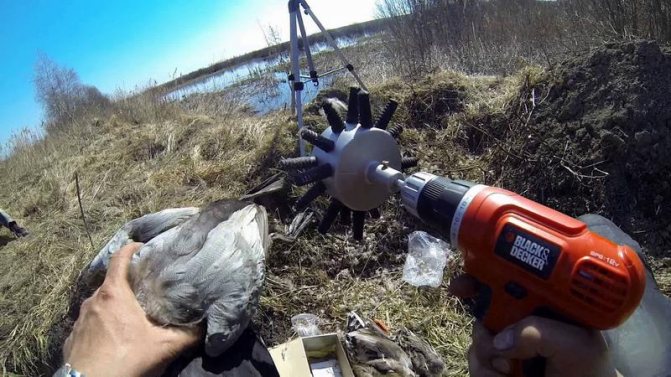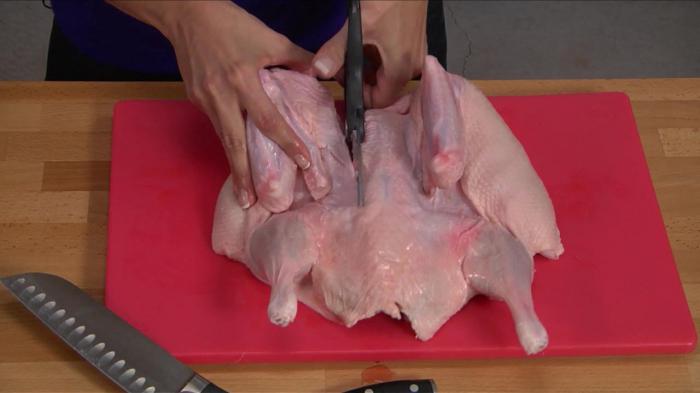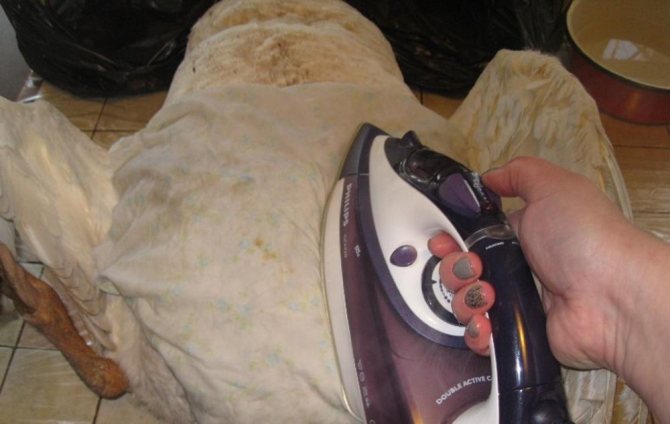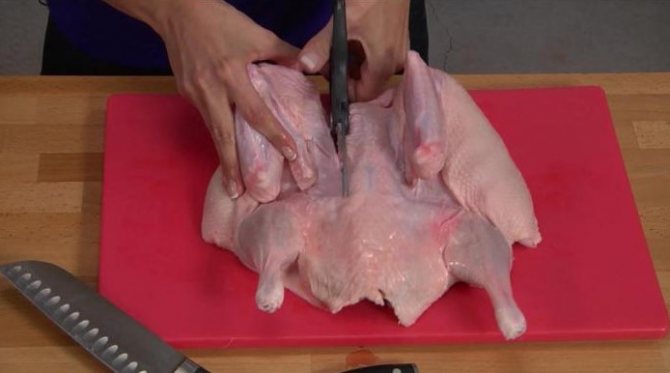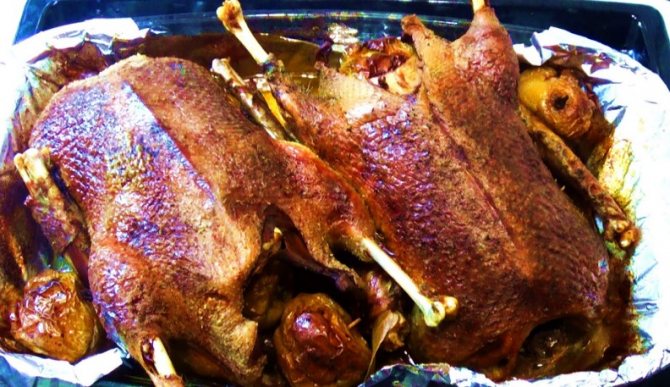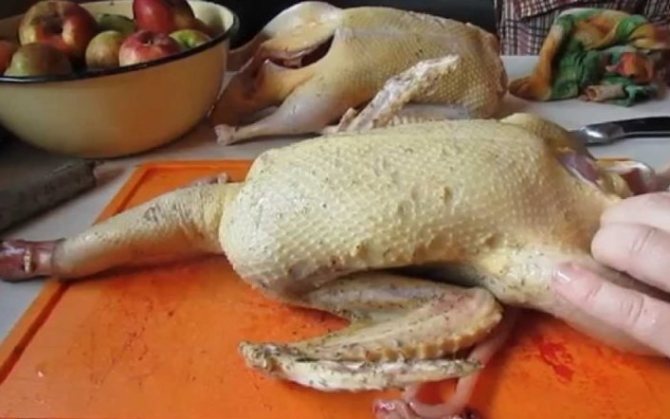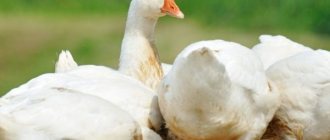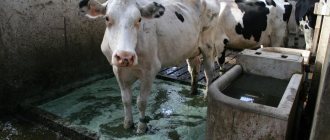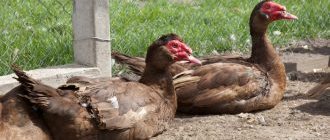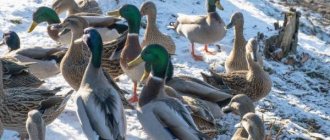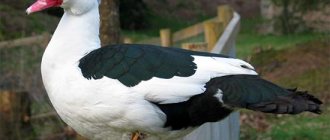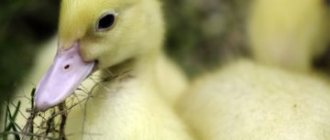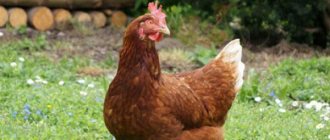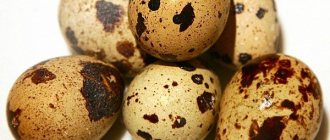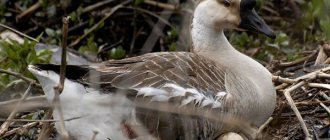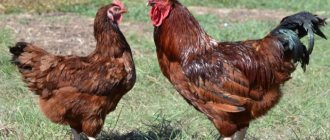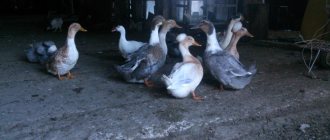Not only a farmer, but also a city dweller should know how to pluck a duck quickly and correctly at home; it is never known when this skill might come in handy. After all, now you can buy fresh duck on the market, which has not yet been plucked. Our article will help you not to get confused and to carry out this procedure in accordance with all the rules.
Before we move on to the analysis of specific methods of plucking feathers from ducks, pay attention to the general rules and recommendations.
Preparatory activities
First of all, it should be noted that before killing the selected duck, it is necessary to familiarize yourself with several key conditions, the consideration of which is highly desirable. It is strongly discouraged to ignore them, so that the result of the procedure performed does not disappoint the owner of the bird. So, it is not worth hammering a duck, the weight and dimensions of which do not reach the average values.
As for other significant rules that provide for the preparation of this bird for slaughter, their list looks like this:
- Regarding how much time the duck should not be fed before slaughtering, it is worth noting that this period is within 12-15 hours. Also, if its owner plans to kill a bird in the morning, it can be organized night fasting.
- Regardless of the option chosen for preparation for slaughter, the duck must be provided with free access to water.
- The room chosen for keeping the poultry should be illuminated throughout the night.
All of the above measures must be taken into account so that the intestines of the duck sent for slaughter are empty.
How to pluck by hand
There are several ways to handle a hammered duck. Feather removal can be dry or hot water, manual or mechanical.
Dry method
The easiest way to manually pluck a bird is also suitable for handling ducks. Special knowledge is not needed here, but only patience and diligence are needed. Hunters in the field, if possible, pluck the bird warm - this is easier to do. But, as mentioned above, this can damage the skin. At home, hunting methods are not entirely applicable, especially if the bird was raised for sale. Instructions:
- The duck lays down on a tarpaulin, other fabric or several layers of paper, newspapers, film.
- Large tail and wing feathers are removed first.
- Feathers are removed from the thoracic and cervical regions - here they are small, so the procedure for their removal is quite laborious.
- After plucking large feathers, the fluff is removed, which must be removed either by hand or by singling the carcass.
- The last operation of this method is to rinse the bird with water to remove the remains of feathers and soot from its body.
Important! When burning down from the surface of the skin of a bird, this must be done quickly, because after a few minutes the subcutaneous fat will begin to melt, and this will ruin the presentation of the product.
In addition to the dry method of plucking birds, there are more professional methods that help to do the job better. One of them is scalding a duck carcass. After such an operation, feathers are much easier to remove.
Instructions:
- The water heats up to 80 ° C - you can damage the skin of the duck when plucking feathers.
- The bird is dipped in a pot of water for a minute.
- Feathers are plucked from the wings towards the tail, regardless of the direction of growth.
- The last to be removed are the feathers in the chest and cervical regions.
- The carcass is scorched over a fire to remove small inclusions - fluff, feathers, hairs.
- The duck is washed with running cool water.
Another method of plucking ducks is to use a cloth bag and iron. For the procedure, you will need an iron, a basin, a cloth bag and water.
Instructions:
- The bag is soaked in water for 15 minutes, after which it is wrung out.
- The poultry carcass is placed in a bag that is tightly tied.
- The duck bag is immersed for 5-7 minutes in a container with hot water (about 80 ° C).
- While the carcass is in water, the iron is heated to its maximum temperature.
- The bird is ironed through a wet bag with a hot iron. In this case, you need to ensure that there are no folds on the bag and that the entire area of the carcass has undergone such a heat treatment.
- The duck is taken out of the bag and plucked.
Read next: When and how to plant broccoli for seedlings: planting at home
Did you know? Not every duck has full-fledged down, which is why it is so prized - hens pluck it from the belly and breast to warm their clutch.
General recommendations
So, you should not pluck ducks immediately after slaughter, according to experts, you need to wait at least 2-3 hours. This pause will give you the opportunity to preserve the skin, as the subcutaneous fat will harden during this time. It is best to start plucking with large feathers, for example, from the wings and tail, gradually, as they peel, moving to small ones. It is necessary to pull out the feathers in the direction of their growth and in no case do not mind. In many sources, you can find the opposite information, but experienced poultry farmers recommend plucking this way, as this allows you to maximally protect delicate areas of the skin from injury. But note that these recommendations apply only to large feathers, while small ones can be plucked both in the direction of growth and against.
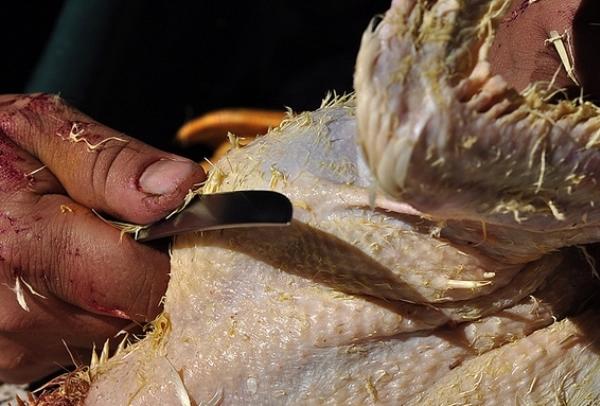
After getting rid of feathers, a light fluff may remain on the skin; it is best to remove it with a blunt knife. A little advice from experienced farmers: so that the fluff does not fly in all directions and interfere with your work, you must sprinkle it with water before plucking.
Having familiarized ourselves superficially with this procedure, let's find out more specifically about how to pluck a duck correctly and what methods are best to use.
Slaughter of poultry
As practice shows, the most popular method by which duck slaughter can be carried out is external. The reason for this is extremely simple: this technique has been tested by many generations of poultry farmers, featuring maximum simplicity and reliability. Guided by its rules, anyone can slaughter a duck, even a novice owner of such birds.
This circumstance is especially important for those who seek to solve the problem under consideration at home, without having any special tools or specific skills. Of course, a duck can be hacked to death, however, the above method of killing this bird is considered much more preferable.
So, for everyone who wants to know how to properly hammer a duck with an external method, it is reasonable to familiarize yourself with the following sequence of actions:
- The bird needs to be hung upside down, while laying one wing after the other. Also, in such cases, it makes sense to use a special metal cone.
- The duck's neck must be extended, and then the carotid artery located on it must be cut.
- Having carried out the above action, you need to wait until the body of the bird is bled. As a rule, this takes a little more than a quarter of an hour.
Guided by the simple recommendations listed above, everyone can properly hammer their duck. Also, anyone can familiarize themselves with the many videos on this topic that are present on the vastness of the World Wide Web and allow you to accurately solve this problem.Well, after the blood stops flowing from the body of the killed bird, you can proceed to the implementation of further measures, which are plucking the carcass and its subsequent cutting.
Duck meat can be used to make many delicious dishes. They are especially relevant on holidays. The process of preparing poultry dishes will not take much time and effort. However, before you cook your poultry, you need to have it ready to cook. Poultry bought on the market or raised on your own farm can be a problem.
According to experienced farmers, duck slaughter is best done by looking at the plumage condition. The best time for slaughter is after 2-2.5 months after the birth of the bird. The plumage should be rough during this time period. It is also necessary to pre-prepare the bird for slaughter. Farmers advise not to feed her about 12-16 hours before slaughtering. To avoid "stumps", poultry slaughter is done before the onset of frost.
It is best to use the external method of killing duck when it needs to be done at home. Other methods are also used:
- a live bird is hung upside down by its paws, laying the wings one by one or, using a metal cone-shaped container;
- tighten the neck of the duck and cut the carotid artery with a knife;
- after 20-30 minutes the body of the bird will be drained of blood and the process of plucking and cutting the carcass can be started.
Preparing for plucking
The pluck is preceded by the slaughter of the duck. In the household, the slaughter period is determined precisely by the state of plumage. The best moment is considered to be 60-65 days of life, when the cover has fully grown, but the flight feathers have not yet ripened. For ease of removal, these feathers are allowed to grow up to 1-1.5 cm, so it will be easier to pick them up. However, the operation should not be postponed for more than 10 days. When the wing covering matures, it leaves a lot of hemp and bristles. The carcass will not work outwardly attractive.
Having decided on the day of slaughter, the bird is put on a starvation diet. For at least 12-16 hours, individuals feed only on water so that the goiter, stomach and intestines of the carcass are cleaner. The duck spends the last night under the lighting, in isolation from the flock.
12 hours before slaughter, ducks only drink water, they are not allowed to eat.
Killing is easiest to accomplish after stunning with a blow to the head. The body is suspended by the legs and the carotid artery is cut. The knife is held sharply, with a slight downward slope. Then it is necessary to keep the carcass in the same position over the bucket for about 10 minutes until it is completely exsanguinated. In the process, it is convenient to use special cones that do not allow the duck to lose its shape. When the blood has stopped flowing, you can start removing the feathers.
How to pluck with a nozzle
Technological progress has also reached poultry, making it possible to use mechanical devices for plucking birds at home. This will help the so-called feather attachment for a drill, hammer drill or grinder. The device has a rather "prickly" appearance with multidirectional corrugated rubber "fingers".
To use the attachment, a drill, perforator, screwdriver or other power tool with an adjustable rotational movement is used. The work of the nozzle consists in plucking feathers from a duck using a device that, with its movements at high speed, imitates the movements of human fingers. To pluck in this way, you just need to securely fix the instrument and bring the bird carcasses to it.
Read more: Early pink Muscat grapes. Muscat grape varieties - an overview with a photo
Mechanical ways to remove feathers
Modern developments of specialists and amateurs offer mechanical devices for plucking birds. There are drill bits and whole machines.
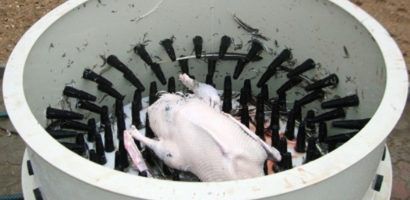

Feather puller
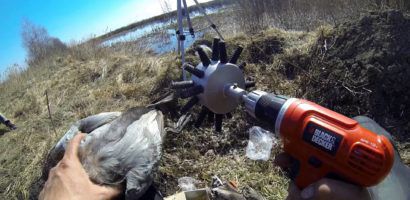

Feather puller
The attachments are wide bits with rubber fingers. It is difficult to remove flight feathers with them, but they cope with smaller ones quite well. The video below shows what the attachment looks like and how it works.
Video - How to pluck a bird with a nozzle
Feeder machines are larger in size, but more efficient when processing a large number of carcasses. The wefts are placed in a finger drum that spins like a washing machine. Craftsmen make such units just from such old technology. The second option for an amateur feather remover is a large pan with a motor.
Feeder prices
Feathering machine
Video - DIY feathering machine
Video - Feathering machine from a pan


Duck storage methods
Cutting technique
Having completed the procedure for plucking a duck carcass, you can start cutting and gutting it. If we single out the first action envisaged in a similar situation, then such is the removal of the intestines. In order to perform it, you need to make a special hole in the anus of the carcass (if the intestines are not removed, then the latter cannot be stored in the refrigerator for a long time). As for the next steps, their sequence is presented in the following list:
- Before gutting a broken bird, it is important to cut off its neck.
- Next, the wings and legs are separated. The first must be cut along the line of the initial, and the second - a couple of centimeters below the heel joint.
- The carcass should be gutted after the appropriate incision has been made on the belly. Subsequently, the removed offal can be used as ingredients for minced meat or broths.
- Do not forget about the removal of the goiter and esophagus. Correct cutting of duck involves removing it through a hole in the neck.
Before butchering the carcass, it should be gutted. A longitudinal incision is made in the abdomen with a sharp knife and all the insides (offal) are removed. This is the first step if the person plans to put the bird in the refrigerator for a while. Gutted lungs, ventricles, and liver should not be thrown away, they are used to prepare first courses.
Correct slaughter of ducks at home and its cutting consist of several stages:
- before gutting, the neck is cut off on the carcass;
- then the wings are cut off, the legs are just below the heel joint, and the wings are at the junction with the initial joint;
- the esophagus and goiter should be gutted through the cervical opening;
- fatty deposits that have formed in the abdomen are excised.
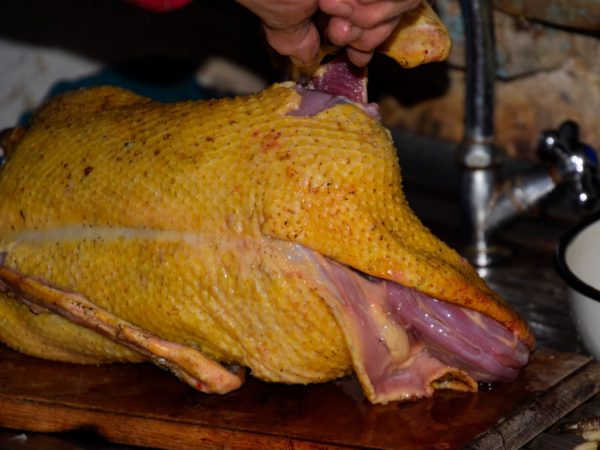

The first step is to remove the intestines. This procedure is important, especially if you intend to send the duck for freezing.
After gutting is finished, the carcass is thoroughly washed in several waters, dried, and placed entirely in a refrigerator or freezer for storage. If the hostess slaughtered the duck and is going to cook it immediately after gutting it, it is important to properly cut it into portioned pieces. The first step is to grope for the joints and make incisions at their joints. This will prevent the risk of crushing bones during cutting and getting them into food.
It is possible to cut the duck in the following way:
- First, using a knife, the hams are separated, making a larger grip of the meat on the back.
- In the same way, it is required to cut the wings closer to the vertebrae.
- The brisket should be cut along the body.
- Use kitchen scissors to cut the tail and ribs.
- Fillet is divided into several parts, having previously freed from the sebaceous gland, which impairs the taste of the meat.
- After cutting, there will be one frame with a skin, which is cut off. The frame is not thrown away, it is better to chop it into pieces or leave it whole, and then use it to prepare broths and other first courses.
Slaughter and butchering of ducks DETAILED! // Life in the village.
Slaughtering a bird, how to pluck and singe a goose or duck - we show and tell you in detail.
Plucking immediately after slaughter
Removing feathers from freshly killed game is preferred by most hunters. It is convenient in terms of cleanliness in the house, freezing and cooling in portable equipment. In addition, many people know that the crispy skin on fried or smoked duck is a gourmet delicacy. It does not allow fat to flow out and dry meat with fire, retains a specific aroma, for the sake of which the race for the bird is started.
As a standard, the process takes place in the usual dry way. Then the carcass is singed on a fire, the head, paws, lower phalanx of the wings are cut off, and gutted. The semi-finished product is sent to the smokehouse, to the fire or spit, to the pot.
However, experienced hunters do not like to spend a lot of time plucking feathers in the field. They prefer to use wax instead of tweezers and fingers. The operation is much faster. You can also resort to this trick at home.
Necessary tools:
- a large boiler with boiling water;
- a similar boiler with cold water;
- a piece of paraffin wax;
- knife and wire cutters.
Tools needed to pluck duck immediately after slaughter.
Paraffin wax can be bought in shops like "Hunting and Fishing", shops with hobby goods and manicure departments. Each bird requires 1 small block (about 10 x 10 cm). In stages, the wax pluck looks like this:
Step 1. Remove legs and wings. Use the usual method with a pair of wire cutters and a knife If necessary, these parts can be left in place to further identify the type of carcass. Some hunters advise leaving the legs to hold the duck by them during further processing steps.
Step 2. Pull tail feathers out of the tail and wing feathers (if retained). You need to pull according to growth. They lend themselves even to hands without tweezers.
Step 3. Pluck the largest feathers from the body against growth. It is better to pull and tear off by gripping the thumb and forefinger. Place the carcass temporarily on a clean surface.
Step 4. Prepare pots full of freshly boiled and cold water.
Step 5. Remove the container with boiling water from the heat. Melt a block of wax in it. The desired state is when a thin film of paraffin floats to the surface.
Step 6. Dip the game. With a quick motion, dip the duck into the wax that has collected on the surface. It is advisable not to tear the paraffin film so that it completely envelops the carcass. Keep it for no longer than 2-3 seconds. Overheating threatens with bursting entrails and spoilage of meat.
Step 7. Transfer birds immediately to a bucket of cold water. Dip for 1-2 minutes until the wax cures. It is also important not to overexpose.
Step 8. Carry out "epilation". Squeeze the bird in the abdominal region. The coating will crack. Now it is convenient to remove the wax in pieces. Rip off all the paraffin.
The result is a smooth, flesh-colored duck with a slight pink tint. Singing such a carcass is no longer required.
Used wax can be heated, filtered, cooled and reused. An alternative to paraffin wax is boiling resin. The principle of operation is completely similar.
Evisceration
In the field, after plucking, it is preferable to immediately carry out gutting.
Step 1. Cut off the head. If the skin with feathers was removed, at this stage the skin must be pulled over the head and the junction of the neck and torso must be cut with nippers. When plucking, simply cut off the neck as close to the shoulders as possible.
Step 2. Ampute the tail. The tail is a small piece of fat at the back of the carcass. With nippers or a blade, separate this piece in a circle.
Step 3.Cut the ribs. Below the ribs, the duck has no meat. The easiest way to remove the internal organs is by making an incision between the base of the breast and the rest of the cavity. Use a knife to rip open a few strips under the breastbone.It is better to start from the sides, moving towards the center. When the incisions are made, fingers are inserted into the middle. Then it is enough to pull on yourself with a careful, but intensified movement. The upper part of the bird must be firmly held with the other hand. The peritoneum will move away with the intestine. Often the liver and heart exit at the same time.
Step 4. Remove the liver, heart, if they did not come out earlier.Cut off the stomach. Separate the bile sac from the liver (green capsule). These organs can be removed through the top if the intestine for some reason has not left with the peritoneum and there is a risk of touching it. The bile and intestinal contents should not be allowed to leak onto the meat. This will ruin its taste.
Step 5. Draw out the remains of the esophagus.Cut off a piece of pulp with a bullet, if not already done. Rinse the carcass.
The most valuable part of the duck is the breast fillet. Hunters for meat, in order to save space, immediately separate only it. In this case, the process looks somewhat different. After bending the skin up to the neck, they step on the head with one foot, and on the paws with the other. The skin is placed under the back, the abdomen is turned up. The brisket is pulled out, the rest of the carcass, including the organs, remains on the ground. The belly is trimmed for fillets. Put your fingers under the bone near the fork on the neck. With the other hand, they grab the bone of the sternum near the lower ribs. All that remains is to pull the meat hard, but slowly, swinging the skin back and forth. It will come out along with both wings, if they were not previously amputated.
Preserving duck feathers and down
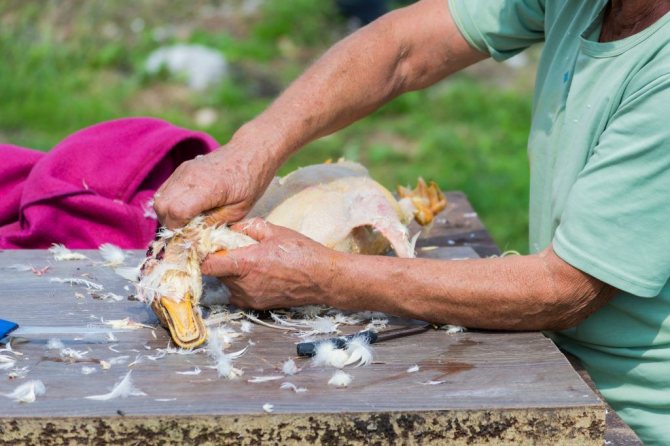

Feathers and down obtained during removal from the bird's body can be useful, so you should not throw them away. The thermal insulation properties of the duck family down are highly appreciated by humans and can serve as a heater for clothing.
After the duck is plucked, its down is washed in warm water with a small portion of washing powder, and the feathers are soaked in soapy water for a couple of hours. These measures will help wash away grease, body residues and unpleasant odors. Next, the fluff is washed with cold running water and wrung out.
Read more: Potatoes Zhukovsky early characteristic of the variety
Did you know? Although the neck size is not the largest, even in comparison with other poultry, the cervical vertebrae in a duck are larger than that of a giraffe!
Duck evisceration
Objective: get rid of the intestines without damaging it. When gutting a duck, you need to be careful not to accidentally cut through the intestines.
During this time, the intestines of the ducks are almost completely freed from the contents.
The most convenient scheme for gutting a duck is when the entire duck intestine remains intact. Better not to cut it out in parts. The contents of the intestines can enter the abdomen of the duck carcass and spoil the meat.
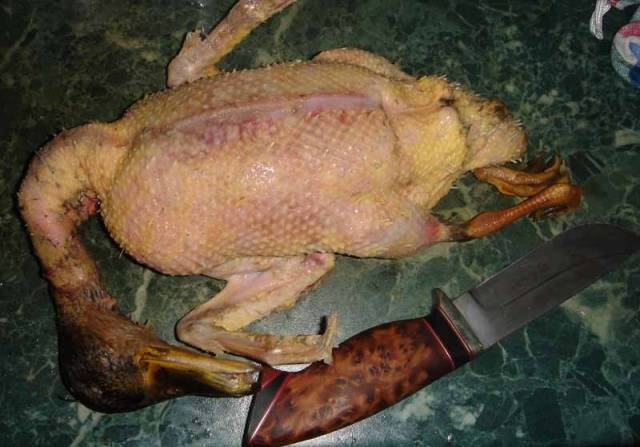

How to cut a duck correctly:
- with a knife, an incision is made in the flexor tendons between the metatarsal and thigh and the duck paw is bent in the opposite direction to the natural one;
- the duck's paw breaks at the joint. The remaining tendons are cut with a knife. They do the same with the second paw;
- lay the duck on its back, with its neck towards itself;
- pull the skin on the neck with a hand from below;
- a sharp knife is carried along the neck of the duck along, cutting the skin. The fingers will be protected by the neck, but it is better that the knife does not slip;
- pick up the cut skin and rip the skin away from the neck:
- the esophagus and trachea are torn off along with the skin. They are torn from the skin to the maximum possible depth inside the duck. From this side everything;
- turn the duck with its tail towards itself and carefully, with the sharpened tip of a knife, make an incision in the skin from the keel towards the anus, making sure not to touch the intestines;
- stick your fingers into the hole formed and tear off the incision with your fingers;
- the duck has thin bones closer to the tail. Spread the skin between the tail and the bone with two fingers and make a transverse incision. When cut from both sides, the anus will be almost separated from the duck's tail;
- capture the anus with the intestine and cut it in the direction "from the duck" - from the bottom up;
- stick their hand inside the duck carcass, tearing the films connecting the giblets with the body of the duck;
- reach the esophagus and grab it with the middle finger, pinching it between two adjacent ones;
- with a raking movement, the gastrointestinal tract is pulled out of the duck together with the liver.
The main work is done. The intestines are intact and the contents have not stained the duck carcass.
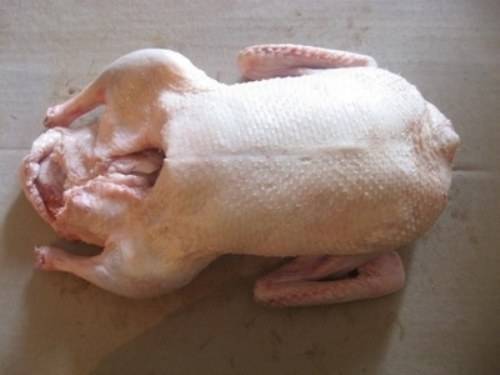

The duck carcass still contains the heart, lungs and trachea. Take out the trachea and heart. The lungs are attached to the ribs and are removed at will. The heart is washed from the blood and left to itself, the trachea is given to the four-legged starving people, if they are in the house.
Now we need to deal with the stomach and liver. The liver must be carefully separated from the intestines so as not to damage the gallbladder.
The duck stomach is cut from the intestines and cut open to clean out the contents. The film also needs to be removed. Interestingly, the gastric film can be removed very easily, or it can "hold on to the last" and this circumstance does not depend on the age of the duck, nor on the diet, nor on the conditions of keeping the ducklings. But you need to remove the film, it gives bitterness during cooking.
After having dealt with the entrails, they return to the duck carcass. It is also necessary to cut out the sebaceous gland on the duck's tail, since this specific fat will spoil the whole dish with a smell.
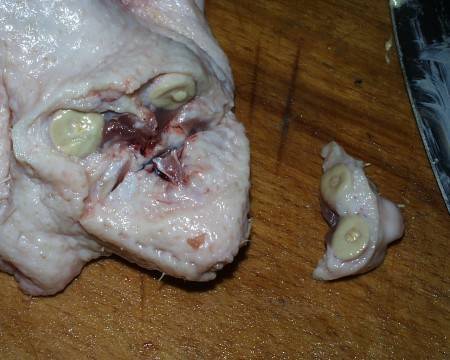

There is no meat, only fat. By carefully cutting the soft tissue around the tail up to the spine, the tail can be easily torn off in a circular motion.
After the duck is gutted, we decide whether it is necessary to skin it.
Next steps
Having finally gutted the broken bird, you can start rinsing it with running water, drying it and then freezing it. If the carcass is intended for the preparation of a particular dish without delay, then the sequence of further actions is as follows:
- First of all, the hams are separated by means of a suitable knife - so that the meat is captured as close to the spine as possible. Wings should be treated in the same way.
- The sirloin must be cut lengthwise, and scissors can be used to separate the ribs and tail.
- It is advisable to chop the meat into several portions, not forgetting to first get rid of the sebaceous gland. The latter can make the taste and smell of duck meat much less pleasant, and therefore this recommendation should not be ignored.
- As for the skin, it can be melted directly with fat, and it makes sense to use the remaining ridge of the beaten bird in the manufacture of various first courses.
Slaughtering duck at home
Slaughter and butchering of ducks DETAILED! // Life in the village.
In the end, it remains to note that both ordinary domestic ducks and their musky cousins - Indo-ducks, whose popularity is steadily growing every year, can be butchered in this way. This thesis is also true for the wild representatives of this biological species, with the only difference that in the process of cutting birds killed in the hunt, it is necessary to pay increased attention to removing pellets from the carcasses stuck in them.
Useful Tips
In order to quickly and efficiently pluck a duck grown on a home farm, you need to know the rules for the procedure. It is worth listening to the advice of experienced poultry farmers. These guidelines will help make it easier to remove feathers and then butcher the duck:
- It is better to pinch a bird outdoors. So the house will not have an unpleasant smell and a lot of debris.
- Before starting the procedure, you must completely release the blood from the killed duck.
- Plucking the bird should be confident, with sharp movements, grasping the feathers with the index and thumb.
- Before removing feathers and fluff, remove the skin from the paws.
- If the nib sits deep enough, tweezers or tweezers are best. This will prevent damage to the skin.
- Before cutting, the wild bird is checked for the presence of fractions in the carcass.A duck caught in a hunt is soaked for several hours.
- The gutted and cut carcass is stored in the refrigerator or in the freezer. Sometimes farmers resort to salting, which increases the shelf life of the meat.
Plucking and then eviscerating poultry or wild birds requires certain knowledge and skills. However, with clear instructions, even a beginner can handle the job. The key is to follow the rules and act with confidence. And then it will not be difficult to pluck and butcher a duck, goose or Indo-duck.

